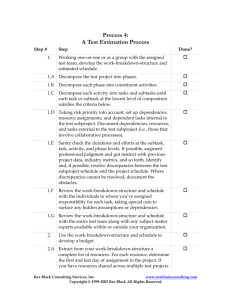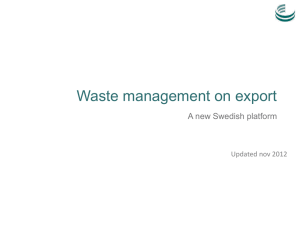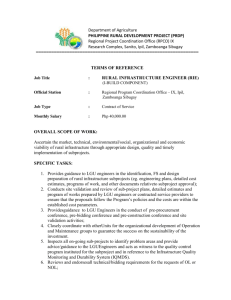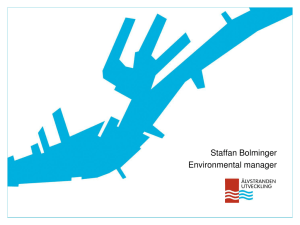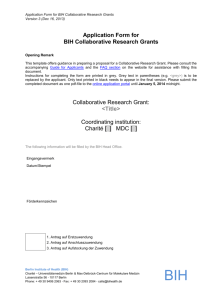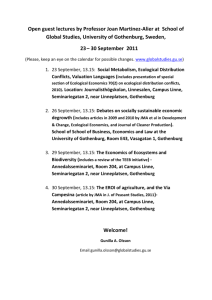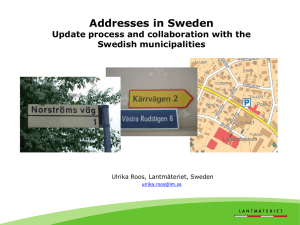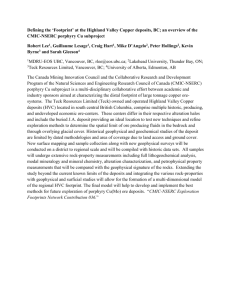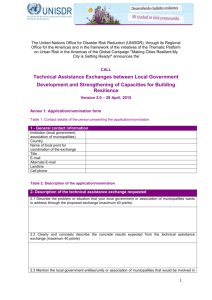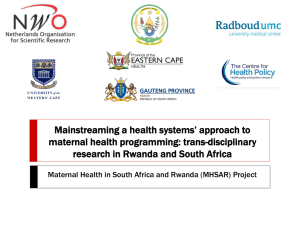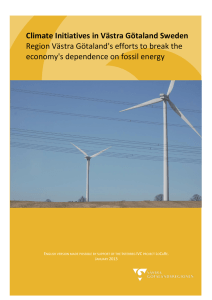- Mistra Urban Futures
advertisement
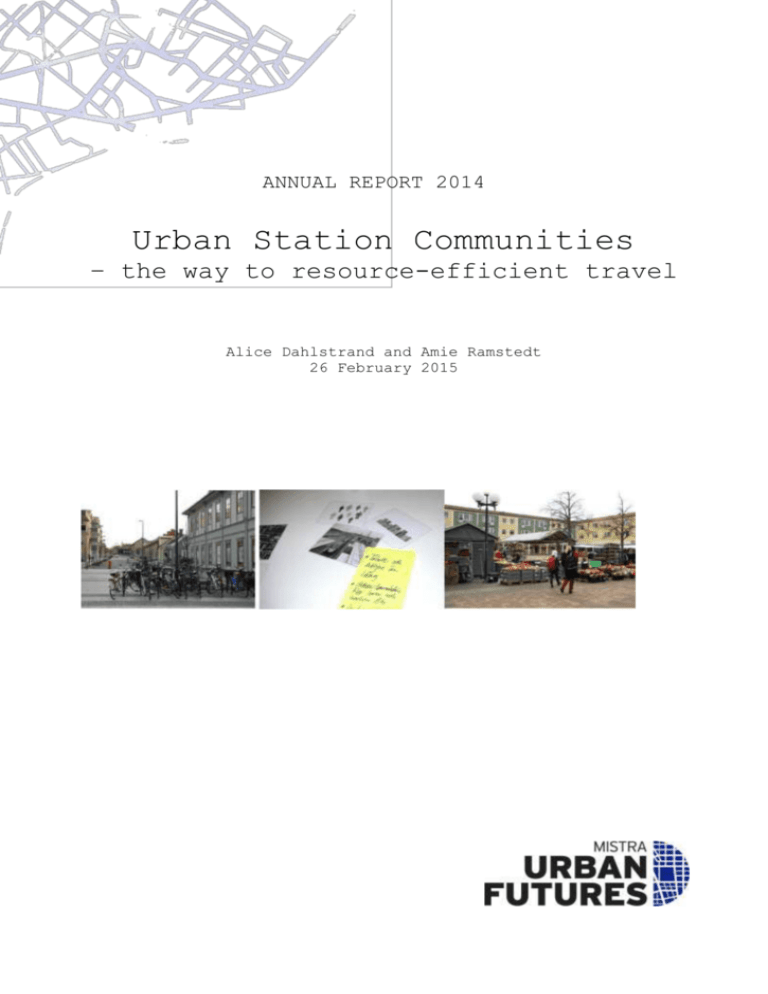
ANNUAL REPORT 2014 Urban Station Communities – the way to resource-efficient travel Alice Dahlstrand and Amie Ramstedt 26 February 2015 Index About the overall knowledge process 3 Background and purpose of the project .................................................................... 3 Focus of the work in 2014 .................................................................................................................. 3 Process management and steering group ...................................................................................... 3 Subprojects ........................................................................................................................................ 4 From knowledge creep to transdisciplinary knowledge agents: sharing and translating knowledge into urban station community development ................................. 4 2.2 Safety and pleasant sound environment in urban station communities .................................. 4 2.3 The role of stations in developing small communities and the areas around them .............. 4 2.4 Sustainable and attractive station communities ........................................................................... 5 3. Associated projects .......................................................................................................................... 5 3.1 Service production for sustainable and dynamic towns – design of collaboration platforms in complex planning processes – ongoing ........................................... 5 3.2 Low carbon stations for low carbon cities ....................................................................................... 6 3.3 Climate-smart and attractive transport nodes............................................................................... 6 4. Major project meetings and seminars ......................................................................................... 6 4.1 Seminar: A pleasant sound environment from source to receiver, 21 January ..................... 6 4.2 Get-together workshop, 28 February .............................................................................................. 6 4.3 Seminar: Urban station communities – how are we to plan for travelling in the near future? 15 May .............................................................................................. 7 4.5 Information and knowledge meeting, 12 December .................................................................... 7 5. Other events in the project ............................................................................................................ 8 Trainees and students ................................................................................................................................. 8 Link to other platforms ............................................................................................................................... 8 6. Impact indicating the project’s success ....................................................................................... 8 1. 1.1 1.2 1.3 2. 2.1 1. About the overall knowledge process 1.1 Background and purpose of the project The future role of station communities is critical in the development of towns and regions. Developing said communities will promote: social and land-use planning that is transport-efficient; sustainable economic development; and, region attractiveness. Urban development around stations is a challenge shared by many bodies and stakeholders. “Urban Station Communities – the way to resource-efficient travel” is a knowledge process within the framework of Mistra Urban Futures. In “Urban Station Communities”, various subprojects are initiated along with activities aimed at increasing knowledge about: the complex elements in station area planning; and, creating the right conditions for developing station communities into attractive and sustainable places in which to live and set up home. In 2012, a research and practice overview (Mistra Urban Futures Rapport 2013:3) was drawn up. In 2013, the project was given a more formal structure when the Gothenburg Region’s Federation of Municipalities, the Swedish Transport Administration, the Västra Götaland region and the Västra Götaland county administrative board decided to finance process management for the project. Agreements on financial contributions were also concluded with participating municipalities. Our work in 2013 is described in Lägesrapport 2013 (“Status Report 2013”). The report you now have in your hands gives an account of what happened in 2014. 1.2 Focus of the work in 2014 Process management in 2014 focused on developing our operations, clarifying direction and initiating subprojects and activities. The overall “Urban Station Communities – the way to resource-efficient travel” knowledge process now involves the following parties: The Västra Götaland county administrative board the Gothenburg Region’s Federation of Municipalities. The Swedish Transport Administration. The Västra Götaland region. Eleven municipalities (Ale, Alingsås, Borås, Kungälv, Lerum, Gothenburg, Härryda, Partille, Stenungsund, Trollhättan and Varberg). Several other partners are involved in various subprojects and activities. Subprojects and activities are initiated based on the seven focus areas set out below. These have been jointly identified by the project parties as critical for developing urban station communities. Noise, vibration and risk. Dialogue and collaboration. Lifestyle values, identity and local marketing. Structure and design of sustainable communities. Land use and land values. Flexible, sustainable transport. The station’s role in its catchment area. 1.3 Process management and steering group In 2014, a regional steering group for the overall knowledge process was appointed. It comprises managers from: the Swedish Transport Administration; the Västra Götaland county administrative board; the Gothenburg Region’s Federation of Municipalities; the Västra Götaland region; and, Mistra Urban Futures. Throughout the year, Alice Dahlstrand of the Swedish Transport Administration and Amie Ramstedt of the Gothenburg Region’s Federation of Municipalities have taken care of process management for the overall project. To reinforce process management, Mistra Urban Futures has granted the project funds for a researcher. In December 2014, an agreement was entered into with Ulf Ranhagen, professor at the Royal Institute of Technology (KTH), architect at Sweco AB and former member of Mistra Urban Futures’ board. Ulf Ranhagen’s assignment in 2015 included: providing research support; developing an overall project in preparation for the upcoming programme period in Mistra Urban Futures; and, assisting with and planning workshop seminars. 2. Subprojects Below, there are details of the subprojects started during the year within the framework of “Urban Station Communities”. 2.1 From knowledge creep to transdisciplinary knowledge agents: sharing and translating knowledge into urban station community development About the subproject: Based on a discussion at the meeting of 28 February, the initiative for a pilot study was taken. This subproject is a collaboration between academic, regional and municipal bodies in Västra Götaland, Halland and Skåne. Using a series of focus groups, the pilot study aimed to collect important, empiric data about: knowledge nurturing structures; and, relations between the bodies working with the development of station communities. The subproject was led by three researchers: Joakim Forsemalm of the University of Gothenburg and Radar arkitektur & planering AB, subproject manager Ingrid Svetoft of Halmstad University and Magnus Johansson of Malmö University. From autumn 2014 up until the beginning of spring 2015, the subproject conducted focus group discussions in four municipalities – Båstad, Laholm, Trollhättan/Upphärad and Stenungsund. Civil servants and politicians took part in these. The pilot study will be presented in a report in spring 2015. To coincide with completion of a first draft of the report, there are plans to hold a number of workshops. The subproject then plans to continue with an application for sizeable research funds. The subproject is financed by: Mistra Urban Futures; Region Halland; Region Skåne; and, Skåne county administrative board. Subproject participants: Region Halland; Region Skåne; Skåne county administrative board; Radar arkitektur & planering AB; Halmstad University; Malmö University; municipalities; and, GR (Gothenburg region). Contact person: Joakim Forsemalm, Radar arkitektur & planering AB, joakim@radar-arkplan.se. 2.2 Safety and pleasant sound environment in urban station communities About the subproject: This subproject focuses on ways of counteracting the problems of noise, vibration and risk. Currently, these present an obstacle to urbanisation around stations. This is partly because of an unclear allocation of responsibilities and contradictory guidelines (recognised in the government’s proposal for changes in the Environmental Code and in the Planning and Building Act). It is also partly due to deficiencies in today’s solutions in respect of functionality and aesthetics requirements in urban locations. Two kick-off meetings were held in 2014. Subproject management in 2014 was provided by the SP Technical Research Institute of Sweden (SP). In autumn 2014, said management was supplemented by subproject managers from White Arkitekter. As the issue is complex, the subproject’s future financing, direction and management all need to be discussed with several parties at both national and regional levels. In a first phase, the subproject has focused on mapping out responsibilities and roles. A first interim report detailing this will be published in spring 2015. Financed by: The Swedish Transport Administration and SP (consultant, White Arkitekter). Subproject participants: The Swedish Transport Administration; SP; the National Board of Housing, Building and Planning; the county administrative board; and, municipalities (more will be involved as time progresses). Contact person: Krister Larsson, SP, krister.larsson@sp.se. 2.3 The role of stations in developing small communities and the areas around them About the subproject: The purpose of this subproject is to study how a train station at a small site can contribute to regional and local development. Said study will also generate greater knowledge about: the residents; people who may move to the area; and, local entrepreneurs. The subproject will contribute to there being greater consensus and more collaboration between regional and local bodies involved with community and catchment area development linked to public transport. Subproject results may provide valuable knowledge for: the upcoming regional traffic provisioning programme for regional public transport; growth programmes; overview plans; and, other strategic documents. A mapping out and knowledge compilation will be ready in spring 2015. To give details of results and provide input for further work, workshops are planned for spring 2015. Further workshops presenting empirical studies and analyses for the subproject participants are to be held in autumn 2015. Financed by: The Västra Götaland region; Region Halland; and, the Swedish Agency for Economic and Regional Growth (municipalities are making in-kind contributions). Subproject participants: Region Halland; the Västra Götaland region; municipalities; the University of Gothenburg; and, Kulturgeografiska institutionen. Contact person: Linda Billberg, the Västra Götaland region, linda.billberg@vgregion.se. 2.4 Sustainable and attractive station communities About the subproject: This subproject focuses on developing services/solutions linked to efficient land use and sustainable mobility. In spring 2014, VINNOVA (Sweden’s innovation agency) granted the subproject funds for an initiation phase. This initiation has now finished. It focused on: developing subproject operations; the subproject idea; and, writing an application to VINNOVA for funds for stage II. The stage II application focuses on developing the following: Calculation/planning tools for various groups (e.g. planners, estate agents, banks, property owners and developers). A service and incentive platform linked to sustainable mobility. Collecting local mobile services at a single point and linking this to a reward model creates an incentive for sustainable mobility. Service development linked to sustainable mobility. Development of mobile services, largely linked to the supply of goods. Collaboration and dialogue. In phase I, the importance of solutions being developed in close collaboration with the users became clear. Thus, the subproject will work continuously with cocreation processes and being receptive to the need to design solutions in collaborations between the bodies that form station communities – users, traders, builders and municipalities. Stage I is financed by: VINNOVA, the Gothenburg Region’s Federation of Municipalities, the Västra Götaland region, Chalmers, IVL (the Swedish Environmental Research Institute), SP, the municipality of Ale, Balder and Alebyggen. Subproject participants in stage I: the Gothenburg Region’s Federation of Municipalities; the Västra Götaland region; Chalmers; IVL; SP; the municipality of Ale; Balder; and, Alebyggen. Status: If the application for stage II is granted, IVL will take over the subproject management role. The following organisations are in the stage II application: the Gothenburg Region’s Federation of Municipalities; the Västra Götaland region; Västtrafik; the municipality of Lerum; Chalmers; IVL; SP; Viktoria Swedish ICT; the municipality of Ale; Alebyggen; Svensk Fastighetsförmedling; Handelsbanken; Bzzzt; ICA; Derome; Wallenstam; Jutabo; HSB; Skanska; and, Förbo. Contact person: Stage I, Amie Ramstedt, amie.ramstedt@grkom.se; stage II (if granted), Jenny Arnell, jenny.arnell@ivl.se. 3. Associated projects To increase knowledge related to the indicated focus areas, “Urban Station Communities” also collaborates with several other projects. Several of these are described below. 3.1 Service production for sustainable and dynamic towns – design of collaboration platforms in complex planning processes – ongoing The Royal Institute of Technology, Konstfack (University College of Arts, Crafts and Design) and others are running a project regarding collaboration platforms for developing dialogues in complex planning processes. This project is also closely linked with the sustainability certification of town districts (HCS). The project’s finances include funds from VINNOVA. Process management for “Urban Station Communities” has linked in the municipality of Varberg as a case in this project. “Urban Station Communities” will also be closely monitoring this project through having a representative on the project’s advisory board. In this way, the participants in “Urban Station Communities” will be amongst the first to have access to the knowledge that is gathered. 3.2 Low carbon stations for low carbon cities The Swedish Transport Administration has provided economic support for the Yellow design Foundation (YdF) European team of researchers (Anne Leemans and others). This is looking into station areas and how, through more efficient planning of passenger and goods transport flows, carbon dioxide emissions can be reduced. In Sweden, YdF is studying Stockholm, Malmö and Gothenburg. With the aim of drawing up recommendations that can be used in the design of station areas and flows, it is comparing the results with those from other countries. Process management for “Urban Station Communities” has: contributed to the databank used by the project; and, provided contacts for interviews within the organisations concerned. 3.3 Climate-smart and attractive transport nodes The Swedish Energy Agency has supported Ulf Ranhagen of KTH and the KTH/LTU (Luleå University of Technology) research team in work with “Climate-smart and attractive transport nodes” – a study of community development in general for areas around stations. To improve sustainability and attractiveness in the interface between station buildings and the surrounding areas of the community, the project aims to develop new knowledge and new methods for urban design. Research has been extended with workshops in Uppsala, Lund and Borås. It has also been put into an international framework. The process managers for “Urban Station Communities” have contributed to workshops and have had informal contact with the project. “Low carbon stations for low carbon cities” and “Climate-smart and attractive transport nodes” deal with the same overall issues regarding energy efficiency linked to passenger and goods transport in large urban regions. Research in both projects is taking place (or has taken place) in urbanisations that are complementary to one another. At the same time, the research projects are distinct from each other by having a somewhat different approach to achieving their goals – i.e. increasing the energy efficiency of flows versus optimising community development structure. Said structure includes sites in direct connection with the station area (and thus linked to the community’s other areas). Consequently, this can also be regarded as community development linked to the station. Clearly enough, the projects complement each other. Both projects also aim to produce usable knowledge and recommendations regarding methods, designs, etc. The demand for such recommendations is constantly growing. 4. Major project meetings and seminars 4.1 Seminar: A pleasant sound environment from source to receiver, 21 January Target group: Civil servants in municipalities and governmental bodies. Number of participants: 100. The seminar was arranged by, the Swedish Transport Administration, the county administrative board and SP. Seminar content was planned on the basis of the participants’ wishes on the subject. The current state of research and ten companies’ various solutions were presented at the seminar. It was a first step towards a subproject in the problem area. 4.2 Get-together workshop, 28 February Target group: Participating organisations and researchers. Number of participants: 31. Meeting with all project participants to: summarise the work done in 2013; give information on ongoing work; and, jointly plan for the year. The following presentations were given at the meeting: Emelie Göransson, then trainee architect for “Urban Station Communities”, presented the results from image workshops held with all participants in 2013. Joakim Forsemalm (University of Gothenburg) and Karl Palmås (Chalmers University of technology) gave an overview of: trends in the development of the Gothenburg area; and, a project on “the town as a value network”. Linda Billberg and Hanna Blomdahl from the Västra Götaland region presented the background to their project participation. After the presentations, there was a small workshop and the seven focus areas for the work in “Urban Station Communities” were established. Project participants were also able to state which focus areas they were particularly interested in and whether their organisations would like to lead, participate in or follow the subprojects and activities linked to the area in question. Based on this, the participants worked in groups (along with the researchers) and drew up proposals for activities and subprojects. 4.3 Seminar: Urban station communities – how are we to plan for travelling in the near future? 15 May The seminar was arranged in collaboration with the “national research centre for public transport” (K2). Target group: Civil servants, politicians, researchers and consultants Number of participants: 80. The following presentations were given at the seminar: Karolina Isaksson (K2), “ How are we to plan for travelling in the near future?” (Plan indicators for sustainable travel.) Erik Elldér (University of Gothenburg), “The impact of community structure on everyday travel”. Henrik Wester (C4 Teknik, Kristianstad), “Communication in large urban planning projects – findings from the Kristianstad link”. An evaluation of the seminar showed that the participants were very satisfied with the format and content. Future demand is for more in-depth knowledge. 4.5 Information and knowledge meeting, 12 December Target group: Project-participating organisations. Number of participants: 40. The following presentations were given at the seminar: Emelie Göransson (project manager, municipality of Varberg), “Resident dialogues in practice – findings from Varberg”. Jan Bengtsson (manager of the tunnel project, municipality of Varberg), “Early collaboration in complex projects – with findings from the station project in Varberg”. Susanne Ingo (the Swedish Transport Administration), “Success factors and make or break issues – Future scenarios, needs and solutions for passenger and goods transport in the station communities of the major urban regions”. Susanne Ingo (the Swedish Transport Administration), “Knowledge and reflections from ‘The attractive region’ project”. The evaluation showed that the content of the inspiration meeting was relevant to the participants’ work/decisions and gave new knowledge and contacts. Many were particularly interested in the dialogue initiatives in the municipality of Varberg. Future demand is for more knowledge about: responsibilities and roles in regional development; and, finance models for travel centres. 5. Other events in the project Trainees and students In 2014, overall process management had one trainee, Gunilla Sundberg. Gunilla has a qualification in human and economic geography and was engaged on a project management traineeship period at Uppsala University. Traineeship activities included an in-depth interview study on the effects of station establishment at Nödinge. Overall process management also had contact with a number of master-level students who, in 2015, will be writing masters theses linked to the project. Link to other platforms During the year, contact was made with other platforms in Mistra Urban Futures. The aim was to discover whether they were running similar projects. As it is planning to start something similar, the platform in Manchester showed interest in being kept up to date about the work in “Urban Station Communities”. 6. Impact indicating the project’s success In 2014, further municipalities joined (Härryda and Borås). “Urban Station Communities” is now something of an accepted concept. It is used by, amongst others, the National Board of Housing, Building and Planning (as an in-depth area in their “Vision of Sweden 2025”). Four funding applications for subprojects have been granted. A number of seminars and large project meetings have been held with great interest being shown by the participants. Several of the organisations have highlighted that, in itself, it is a success that a joint arena has been created in which there are transdisciplinary meetings of organisations and researchers.
